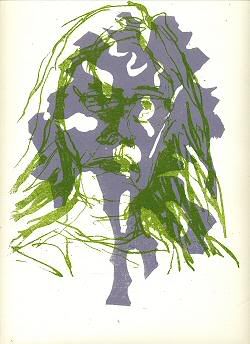Fresh Paint
Sunday, January 30, 2005
Sitting With Hands in Lap
Artblog has snapped pix of just about everything I adore about the contemporary collection (are works 30 or 40 years old still contemporary?) at the Milwaukee Art Museum and added history and thoughts about the Philadelphia Museum of Art. So my job is now done (until the next trip, that is. You can never see it all, and you are a different person each time you look, in any case).
The only thing I wanted to emphasize is how the installation of this art is a work of art itself, and how it gives meaning to a piece that may or may not have been intended to have meaning.
Coming from a mostly-writing background (poetry back in Creeley-esque Buffalo in the old days), perhaps I have to find narrative or at least meaning of sorts in even the most non-objective work.
So let's follow my thinking (and Roberta's pictures), starting with "Atmosphere," the Neil Janney piece (this is the name you were looking for, Roberta). It looks like a mirror above a mantel, but reflects nothing, is merely open and empty. It is placed next to the Donald Judd "steps", each of which are about the same thickness as the frame on the Janney piece. And each step leads up into the (yes, you got it) atmosphere.
The Jackie Winsor box is placed a little in front of the Agnes Martin painting so you are invited to compare squareness and flatness and volume. And you can compare the horizontals of the Judd piece (thickness and volume) with the thin graphite lines on the Martin if you care to.
You turn to your right and see the Eva Hesse cascading streamers of fiberglass (I think), then, magically, out of the corner of your right eye you see a wall-size Robert Morris soft sculpture of cascades of industrial felt. You compare the lightness and sparkling (yet somehow disintegrating nature) of the shapes of the Hesse with the heavy, dark blankets of the Morris piece.
You move closer. To the left, slightly, you see a Sol Le Witt "Incomplete Open Cube". You remember the Jackie Winsor cube and catch it fleetingly in your eye. Which cube is really the incomplete one?
A final pairing is Robert Irwin's light piece, where shadows cast by a translucent disk (rather like the old-fashioned disk covering ceiling lightbulbs, like I still have in my bedroom) are "airy" and insubstantial, fragile, breakable. And to the left, on the wall next to it is (is this a joke, or what?) Joseph Kosuth's "One and Three Hammers (1965)": a picture of a hammer, an actual hammer, and the dictionary definition of a hammer.
That's all. The lighting in the room is a little dim, possibly to protect the objects, but unifies them, too.
I hope they continue to add to this collection, and to shift the objects around as well, so they will tell a new story the next time I visit.
 This work is licensed under a Creative Commons License.
This work is licensed under a Creative Commons License.








